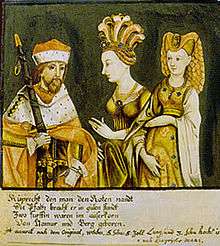Rupert I, Elector Palatine
| Rupert I "the Red" | |
|---|---|
 Rupert I, Elector Palatine, with his wives. | |
| Elector Palatine | |
| Reign | 10 January 1356 - 16 February 1390 |
| Predecessor | new title |
| Successor | Rupert II |
| Born |
9 June 1309 Wolfratshausen |
| Died |
16 February 1390 (aged 80) Neustadt an der Weinstraße |
| Noble family | House of Wittelsbach |
| Spouse(s) |
Elisabeth, Countess of Namur Beatrix of Jülich-Berg |
| Father | Rudolf I, Duke of Bavaria |
| Mother | Mechtild of Nassau |
Rupert I "the Red", Elector Palatine (German: Ruprecht der Rote; 9 June 1309, Wolfratshausen – 16 February 1390, Neustadt an der Weinstraße) was Count Palatine of the Rhine from 1353 to 1356, and Elector Palatine from 10 January 1356 to 16 February 1390.
He was the son of Rudolf I, Duke of Bavaria and Mechtild of Nassau, the daughter of King Adolf of Nassau-Weilburg. With the death of his brother, Rudolf II, on 4 October 1353, he inherited his domains and became sole Count for the territory, whereas they had previously shared that privilege.
The Golden Bull of 1356 guaranteed the Palatinate the right of participating in the election of the Holy Roman Emperor. Previous Counts Palatine had participated in other Imperial elections.
In 1386, Rupert founded Heidelberg University, the third university in the Holy Roman Empire, which was named after him.
Rupert was married twice: firstly to Elisabeth, Countess of Namur (daughter of John I, Marquis of Namur), secondly to Beatrix of Jülich-Berg. Neither marriage produced an heir.
He was succeeded by his nephew, Rupert II, Elector Palatine.[1]
References
| Rupert I, Elector Palatine Born: 9 June 1309 Died: 16 February 1390 | ||
| German nobility | ||
|---|---|---|
| Regnal titles | ||
| Preceded by Rudolf II |
Count Palatine of the Rhine 1353–1356 |
Succeeded by Palatinate recognized as a secular electorate |
| New title | Elector Palatine 1356–1390 |
Succeeded by Rupert II |